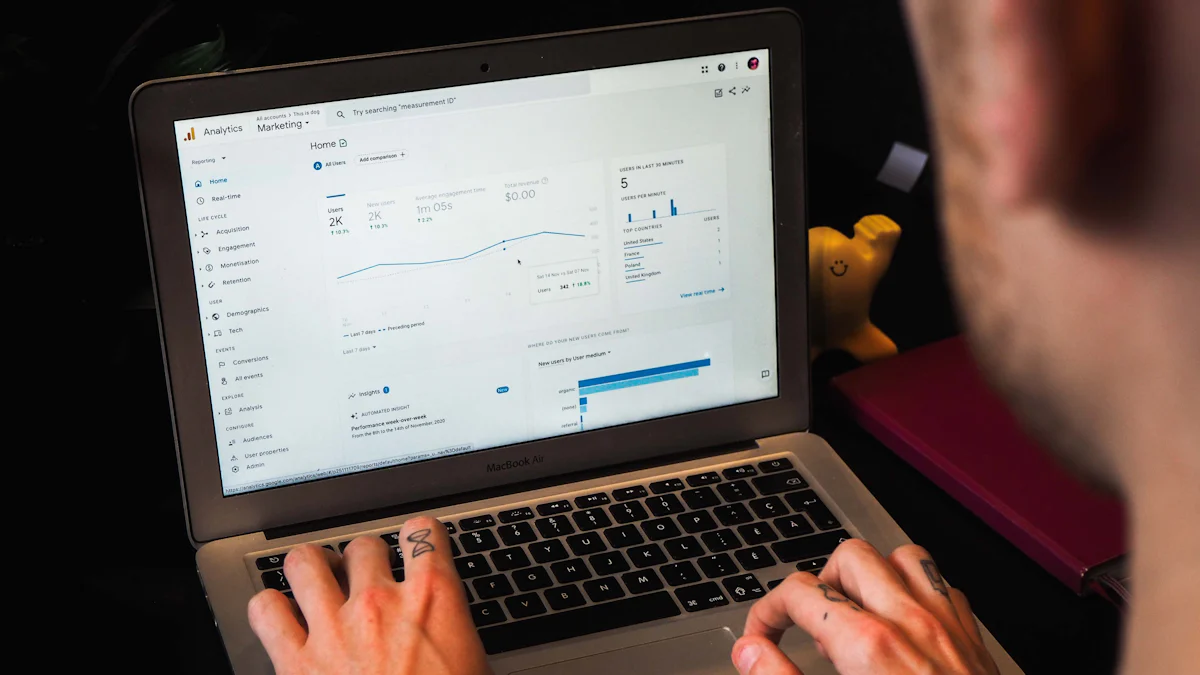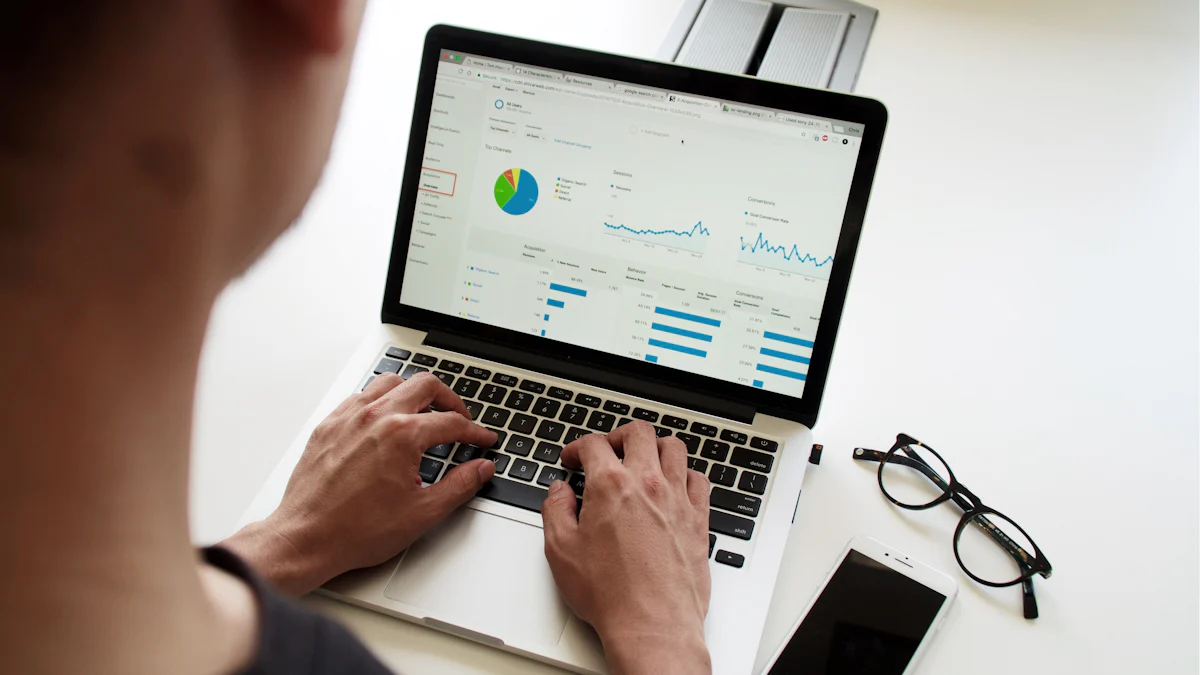


Retail Analytics Software empowers you to make informed decisions by analyzing vast amounts of data. This tool collects and processes information from various retail channels, providing insights into consumer behavior and market trends. By understanding these patterns, you can adapt swiftly to changing preferences and gain a competitive edge. Data-driven decision-making is crucial in retail. It allows you to optimize operations, enhance customer experiences, and increase profitability. Spotting emerging trends before they become mainstream gives you an advantage, ensuring your business remains relevant and successful in a dynamic market.
Understanding Retail Analytics Software
Definition and Overview of Retail Analytics Software
What is Retail Analytics Software?
Retail Analytics Software is a powerful tool that helps you analyze data from various retail operations. It gathers information on inventory levels, sales patterns, customer demand, and more. By using this software, you can gain insights into market trends and consumer behavior, which are essential for making informed decisions.
Key Components of Retail Analytics Software
Retail Analytics Software integrates several key components to provide comprehensive insights:
- Point of Sale (POS) Systems: These systems capture sales data and customer transactions.
- Customer Relationship Management (CRM) Software: CRM tools help you understand customer interactions and preferences.
- Data Warehousing and Big Data Platforms: These platforms store and manage large volumes of data.
- Data Visualization Tools: Visualization tools present data in an easily understandable format.
- AI and Machine Learning Algorithms: These algorithms enhance data analysis by predicting trends and outcomes.
How Retail Analytics Software Works
Data Collection Methods
Retail Analytics Software collects data from multiple sources. You can gather information from physical stores, online platforms, and catalog sales. This comprehensive data collection ensures you have a complete view of your retail operations.
Data Processing Techniques
Once collected, the software processes the data to make it usable. It cleans and organizes the information, removing any errors or inconsistencies. This step is crucial for accurate analysis.
Data Analysis Approaches
The software uses various analysis techniques to uncover insights. You can apply statistical methods to identify patterns and trends. Predictive analytics helps you forecast future sales and customer behavior.
Data Visualization Tools
Data visualization tools transform complex data into visual formats like charts and graphs. These visuals make it easier for you to understand and interpret the data. By using these tools, you can quickly identify key insights and make data-driven decisions.
Benefits of Retail Analytics Software
Retail Analytics Software offers numerous advantages that can transform your business operations and strategies. By leveraging data, you can make informed decisions, optimize processes, and enhance customer experiences.
Improved Decision-Making
Retail Analytics Software empowers you to make better decisions by providing actionable insights.
Data-Driven Strategies
With Retail Analytics Software, you can develop strategies based on real data rather than intuition. This software analyzes consumer preferences and market trends, enabling you to adapt swiftly to changes. You gain a competitive edge by understanding what your customers want and need.
Predictive Analytics
Predictive analytics is a powerful feature of Retail Analytics Software. It allows you to forecast future trends and customer behaviors. By anticipating these changes, you can prepare your business to meet demand, ensuring you stay ahead of the competition.
Optimized Operations
Retail Analytics Software streamlines your operations, making them more efficient and effective.
Inventory Management
Managing inventory becomes easier with Retail Analytics Software. It provides insights into stock levels and sales patterns, helping you maintain optimal inventory. You can reduce waste and ensure products are available when customers need them.
Supply Chain Efficiency
Retail Analytics Software enhances supply chain efficiency by analyzing data from various sources. You can identify bottlenecks and streamline processes, ensuring products move smoothly from suppliers to customers. This efficiency reduces costs and improves customer satisfaction.
Enhanced Customer Experience
Retail Analytics Software plays a crucial role in improving the customer experience.
Personalized Shopping Experiences
By using Retail Analytics Software, you can offer personalized shopping experiences. The software analyzes customer data to understand preferences and behaviors. You can tailor marketing efforts and product recommendations to individual customers, increasing satisfaction and loyalty.
Customer Behavior Insights
Understanding customer behavior is essential for any retail business. Retail Analytics Software provides deep insights into how customers interact with your brand. You can identify trends and patterns, allowing you to refine your offerings and improve the overall shopping experience.
Increased Profitability
Retail Analytics Software plays a pivotal role in boosting your profitability. By leveraging data insights, you can make informed decisions that directly impact your bottom line. This software enables you to understand market dynamics and consumer preferences, allowing you to adapt swiftly and maintain a competitive edge.
Sales Forecasting
Sales forecasting becomes more accurate with Retail Analytics Software. You can predict future sales trends by analyzing historical data and current market conditions. This foresight helps you allocate resources efficiently and plan inventory levels accordingly. Accurate sales forecasts reduce the risk of overstocking or understocking, ensuring you meet customer demand without incurring unnecessary costs.
- Historical Data Analysis: Examine past sales data to identify patterns and trends.
- Market Condition Assessment: Consider current market factors that may influence sales.
- Resource Allocation: Plan inventory and staffing based on forecasted demand.
"Retail Analytics provides insights into changing consumer preferences, allowing businesses to pivot or adapt swiftly."
Revenue Optimization
Optimizing revenue is another significant benefit of Retail Analytics Software. By analyzing pricing strategies and customer behavior, you can identify opportunities to maximize profits. The software helps you determine the optimal price points for products, ensuring competitiveness while maintaining healthy margins.
- Pricing Strategy Evaluation: Assess the effectiveness of current pricing models.
- Customer Behavior Analysis: Understand how pricing affects purchasing decisions.
- Profit Margin Management: Balance competitive pricing with profitability goals.
Retail Analytics Software empowers you to make strategic decisions that enhance profitability. By utilizing data-driven insights, you can optimize sales forecasts and revenue streams, ensuring your business thrives in a dynamic market environment.
Real-World Applications of Retail Analytics Software

Retail Analytics Software is transforming the retail landscape by providing actionable insights that drive business success. Let's explore how it applies in real-world scenarios.
Understanding Customer Behavior
Retail Analytics Software helps you delve into customer behavior, offering a clearer picture of your audience.
Customer Segmentation
You can use Retail Analytics Software to segment customers based on various criteria like demographics, purchasing habits, and preferences. This segmentation allows you to tailor marketing strategies to specific groups, enhancing engagement and conversion rates.
Shopping Pattern Analysis
Analyzing shopping patterns becomes straightforward with Retail Analytics Software. You can identify trends in purchasing behavior, such as peak shopping times or popular product categories. This insight helps you optimize inventory and marketing efforts to align with customer needs.
Inventory Management
Efficient inventory management is crucial for retail success, and Retail Analytics Software plays a vital role.
Stock Level Optimization
Retail Analytics Software enables you to maintain optimal stock levels. By analyzing sales data and demand forecasts, you can ensure that you have the right products available at the right time, reducing both overstock and stockouts.
Demand Forecasting
Accurate demand forecasting is achievable with Retail Analytics Software. You can predict future demand by examining historical sales data and market trends. This foresight allows you to plan inventory and supply chain operations effectively, minimizing costs and maximizing availability.
Personalizing Shopping Experiences
Creating personalized shopping experiences is essential for customer satisfaction, and Retail Analytics Software makes it possible.
Targeted Marketing
With Retail Analytics Software, you can implement targeted marketing campaigns. By understanding customer preferences and behaviors, you can craft personalized messages and offers that resonate with individual shoppers, increasing engagement and loyalty.
Customized Recommendations
Retail Analytics Software allows you to provide customized product recommendations. By analyzing past purchases and browsing history, you can suggest products that align with customer interests, enhancing the shopping experience and boosting sales.
"Retail Analytics provides insights into changing consumer preferences, allowing businesses to pivot or adapt swiftly."
Retail Analytics Software empowers you to make informed decisions across various aspects of retail operations. By understanding customer behavior, optimizing inventory, and personalizing experiences, you can enhance efficiency, adaptability, and profitability.
Challenges in Implementing Retail Analytics Software
Implementing Retail Analytics Software can significantly enhance your business operations, but it also presents certain challenges. Understanding these challenges will help you navigate them effectively and maximize the benefits of the software.
Data Privacy Concerns
Data privacy is a critical issue when using Retail Analytics Software. You must ensure that customer data remains protected at all times.
Ensuring Customer Data Protection
You need to implement robust security measures to protect customer data. Encryption and secure access controls are essential. Regular audits and monitoring can help identify potential vulnerabilities. By prioritizing data protection, you build trust with your customers, which is crucial for long-term success.
Compliance with Regulations
Compliance with data protection regulations is mandatory. Laws such as the General Data Protection Regulation (GDPR) and the California Consumer Privacy Act (CCPA) set strict guidelines for handling customer data. You must stay informed about these regulations and ensure your Retail Analytics Software complies with them. Non-compliance can lead to severe penalties and damage to your reputation.
Integration with Existing Systems
Integrating Retail Analytics Software with your existing systems can be challenging. You need to ensure compatibility and seamless operation.
Compatibility Issues
Compatibility issues may arise when integrating new software with existing systems. You should assess your current infrastructure and identify potential conflicts. Working closely with your software provider can help address these issues. They can offer solutions or customizations to ensure smooth integration.
System Upgrades
System upgrades may be necessary to accommodate Retail Analytics Software. You might need to update hardware or software components to support the new system. Planning and budgeting for these upgrades is essential. By investing in the necessary upgrades, you ensure that your Retail Analytics Software operates efficiently and delivers the desired results.
"Retail Analytics plays a pivotal role in enhancing the customer experience, acting as a linchpin between data insights and customer satisfaction."
By addressing these challenges, you can successfully implement Retail Analytics Software and unlock its full potential. This software empowers you to make data-driven decisions, optimize operations, and enhance customer experiences. Understanding and overcoming these obstacles will position your business for success in a competitive market.
Future Trends in Retail Analytics Software

Retail Analytics Software continues to evolve, offering new opportunities for retailers to enhance their operations. As technology advances, several trends are shaping the future of this software, making it more powerful and efficient.
AI and Machine Learning
Artificial Intelligence (AI) and Machine Learning are transforming Retail Analytics Software. These technologies enable you to gain deeper insights and make more accurate predictions.
Advanced Predictive Models
AI and Machine Learning develop advanced predictive models. These models analyze vast amounts of data to forecast future trends and customer behaviors. You can anticipate changes in the market and adjust your strategies accordingly. This foresight helps you stay ahead of competitors and meet customer demands effectively.
Automation in Analytics
Automation plays a crucial role in Retail Analytics Software. It streamlines data processing and analysis, reducing the time and effort required. You can automate routine tasks, allowing your team to focus on strategic decision-making. Automation enhances efficiency and accuracy, ensuring you make informed decisions based on reliable data.
Real-Time Analytics
Real-time analytics is becoming increasingly important in Retail Analytics Software. It provides immediate insights, enabling you to respond quickly to changing conditions.
Instant Data Processing
With real-time analytics, you can process data instantly. This capability allows you to monitor sales, inventory, and customer interactions as they happen. You gain a comprehensive view of your operations, helping you identify issues and opportunities promptly. Instant data processing ensures you have the information you need to make timely decisions.
Immediate Decision-Making
Real-time analytics supports immediate decision-making. You can act on insights without delay, improving your responsiveness to market changes. Whether adjusting pricing strategies or optimizing inventory levels, immediate decision-making helps you maintain a competitive edge. By leveraging real-time data, you ensure your business remains agile and adaptable.
"Retail Analytics Software is not just about understanding the past; it's about predicting the future and acting in the present."
Retail Analytics Software continues to advance, driven by AI, Machine Learning, and real-time analytics. These trends empower you to make smarter decisions, optimize operations, and enhance customer experiences. By embracing these innovations, you position your business for success in a rapidly changing retail landscape.
Choosing the Right Retail Analytics Software
Selecting the ideal retail analytics software is crucial for maximizing your business's potential. You need to consider several factors to ensure the software aligns with your operational needs and strategic goals.
Key Features to Consider
When evaluating retail analytics software, focus on key features that will support your business growth and efficiency.
Scalability
Scalability is essential. As your business expands, your software should accommodate increased data volumes and user demands. Scalable software grows with you, preventing disruptions and ensuring continuous performance. Look for solutions that offer flexible scaling options, allowing you to adjust resources as needed without significant costs or technical challenges.
User-Friendliness
User-friendliness is another critical feature. Your team should easily navigate and utilize the software without extensive training. Intuitive interfaces and straightforward functionalities enhance productivity and reduce errors. Choose software that offers a seamless user experience, enabling your staff to focus on analysis rather than struggling with complex systems.
Evaluating Vendor Options
After identifying the key features, evaluate potential vendors to find the best fit for your business.
Reputation and Reliability
Reputation and reliability matter. A vendor with a strong track record provides assurance of quality and support. Research customer reviews and testimonials to gauge satisfaction levels. Reliable vendors offer consistent updates and maintenance, ensuring your software remains current and effective. Partnering with a reputable vendor minimizes risks and enhances your confidence in the software's performance.
Cost-Effectiveness
Cost-effectiveness is vital. You must balance quality with budget constraints. Analyze the total cost of ownership, including initial investment, maintenance, and potential upgrades. Cost-effective solutions deliver value without compromising functionality. Consider long-term benefits and return on investment when assessing pricing models. Opt for software that aligns with your financial goals while delivering the necessary features and support.
"Retail Analytics Software empowers businesses to make informed decisions, optimize operations, and enhance customer experiences."
By carefully considering these factors, you can choose retail analytics software that meets your needs and supports your business objectives. Prioritize scalability, user-friendliness, reputation, reliability, and cost-effectiveness to ensure a successful implementation and maximize the benefits of your investment.
Retail analytics software plays a crucial role in modern retail. It empowers you to make informed decisions by analyzing data from various sources. This software enhances your ability to understand customer behavior, optimize operations, and increase profitability. By leveraging these insights, you can stay competitive in a dynamic market.
Embrace retail analytics to transform your business. It offers the insights needed to adapt swiftly and thrive in today's ever-changing retail landscape.
FAQ
Retail Analytics Software helps you analyze data from retail operations. It gathers information on sales, inventory, and customer behavior to provide insights that guide decision-making.
This software is crucial because it enables data-driven decisions. You can optimize operations, enhance customer experiences, and increase profitability by understanding market trends and consumer preferences.
By providing actionable insights, the software allows you to develop strategies based on real data. Predictive analytics helps forecast future trends, ensuring you stay ahead of the competition.
Key components include:
Point of Sale (POS) Systems: Capture sales data.
Customer Relationship Management (CRM): Understand customer interactions.
Data Visualization Tools: Present data in visual formats.
AI and Machine Learning: Enhance data analysis.
The software analyzes customer data to offer personalized shopping experiences. You can tailor marketing efforts and product recommendations, increasing satisfaction and loyalty.
Challenges include:
Data Privacy Concerns: Ensuring customer data protection.
Integration Issues: Compatibility with existing systems.
Look for advancements in:
AI and Machine Learning: For deeper insights.
Real-Time Analytics: For immediate decision-making.
Continue Reading About Retail Analytics Software
15 Best Software Reporting Tools for 2025
Explore the top 15 software reporting tools for 2025. Compare features, pricing, and usability to find the best fit for your business needs.
Lewis
Oct 08, 2024
10 Must-Have Marketing Agency Reporting Tools for Your Success
Optimize your agency's performance with top reporting tools. Explore analytics, social media, SEO, and more for data-driven decisions and efficiency.
Lewis
Oct 09, 2024
Augmented Analytics: Unlock the Core Concepts & Benefits!
Discover augmented analytics—where AI and ML automate data prep and insights, revolutionizing decision-making for smarter, faster business strategies!
Lewis
Mar 04, 2025
Dashboard Anywhere Made Easy for Chrysler Employees
Access Dashboard Anywhere easily as a Chrysler employee. Manage payroll, benefits, and schedules 24/7 with simple login steps and troubleshooting tips.
Lewis
Dec 31, 2024
Data Validation Techniques: Secrets to Achieving Precision and Accuracy
Master data validation techniques from manual to machine learning methods. Ensure data quality with our practical steps.
Howard
Aug 06, 2024
Best Data Management Tools of 2025
Explore the best data management tools of 2025, including FineDataLink, Talend, and Snowflake. Learn about their features, pros, cons, and ideal use cases.
Howard
Aug 04, 2024


